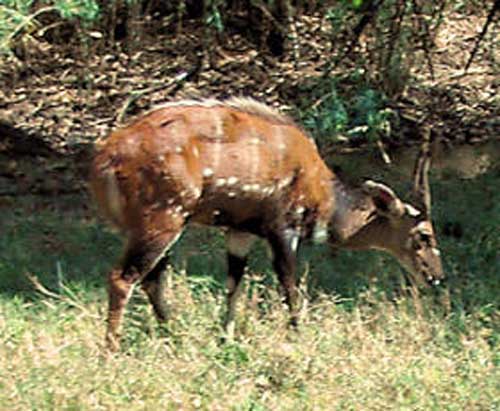
Tragelaphus scriptus (*)
Superregnum: Eukaryota
Cladus: Unikonta
Cladus: Opisthokonta
Cladus: Holozoa
Regnum: Animalia
Subregnum: Eumetazoa
Cladus: Bilateria
Cladus: Nephrozoa
Superphylum: Deuterostomia
Phylum: Chordata
Subphylum: Vertebrata
Infraphylum: Gnathostomata
Megaclassis: Osteichthyes
Cladus: Sarcopterygii
Cladus: Rhipidistia
Cladus: Tetrapodomorpha
Cladus: Eotetrapodiformes
Cladus: Elpistostegalia
Superclassis: Tetrapoda
Cladus: Reptiliomorpha
Cladus: Amniota
Cladus: Synapsida
Cladus: Eupelycosauria
Cladus: Sphenacodontia
Cladus: Sphenacodontoidea
Cladus: Therapsida
Cladus: Theriodontia
Cladus: Cynodontia
Cladus: Mammaliaformes
Classis: Mammalia
Subclassis: Trechnotheria
Infraclassis: Zatheria
Supercohort: Theria
Cohort: Eutheria
Cohort: Placentalia
Cladus: Boreoeutheria
Superordo: Laurasiatheria
Cladus: Euungulata
Ordo: Artiodactyla
Cladus: Artiofabula
Cladus: Cetruminantia
Subordo: Ruminantia
Familia: Bovidae
Subfamilia: Bovinae
Genus: Tragelaphus
Species: Tragelaphus scriptus
Name
Tragelaphus scriptus (Pallas, 1766)
References
Tragelaphus scriptus in Mammal Species of the World.
Wilson, Don E. & Reeder, DeeAnn M. (Editors) 2005. Mammal Species of the World – A Taxonomic and Geographic Reference. Third edition. ISBN 0-8018-8221-4.
Wilson, D.E. & Reeder, D.M. (eds.) 2005. Mammal Species of the World: a taxonomic and geographic reference. 3rd edition. The Johns Hopkins University Press: Baltimore. 2 volumes. 2142 pp. ISBN 978-0-8018-8221-0. Reference page.
Vernacular names
Akan: Wansane
español: Bosbok o antílope jeroglífico
magyar: Közönséges bozótiantilop
The bushbuck (Tragelaphus scriptus) is the nominate taxon of the bushbuck. It is a small to medium-sized antelope widespread in Africa. The Cape bushbuck is a southern and eastern subspecies which is recognised by some authors, which found evidence to consider the northern and southern populations to belong to a different subspecies in 2007.[1][2]
Taxonomy
19 genetically-based groupings were found in a 2007 study, some do not correspond to previously described subspecies, eight of these were grouped under the nominate taxon. Former subspecies included as synonyms to the nominate taxon are phaleratus, bor and dodingae.[3]
As the first of the bushbucks to be described by Pallas in 1766 as Antilope scripta from Senegal, it retains the original species name for the bushbuck.
Description
Bushbucks in general smaller are than other tragelaphines, with a mainly red or yellow-brown ground colour. According to Moodley et al., the males of the West African population are more often striped than those in East or Southern Africa, although bushbuck with striping occur throughout the range.
Distribution
The nominate taxon occurs in Senegal, Gambia, Guinea, Sierra Leone, Ghana and in the Niger Basin in Nigeria as far east as the Cross River, south of the Bamenda Highlands through Cameroon, Chad, the Central African Republic to the Nile in South Sudan (?) and northern Uganda, Gabon, Republic of the Congo, Democratic Republic of the Congo to northern Angola.[3]
Ecology
It is common across its broad geographic distribution and is found in wooded savannas, forest-savanna mosaics, rainforests, in montane forests and semi-arid zones. It does not occur in the deep rainforests of the central Congo Basin.
References
Moodley Y, Bruford MW, Bleidorn C, Wronski T, Apio A, Plath M (2008) Analysis of mitochondrial DNA data reveals non-monophyly in the bushbuck (Tragelaphus scriptus) complex. Mammalian Biology, doi:10.1016/j.mambio.2008.05.003
Wronski T, Moodley Y. (2009) Bushbuck, harnessed antelope or both? Gnusletter, 28(1):18-19.
Moodley Y, Bruford MW. (2007) Molecular biogeography: Towards an integrated framework for conserving pan-African biodiversity. PLoS ONE. 2:e454.
Retrieved from "http://en.wikipedia.org/"
All text is available under the terms of the GNU Free Documentation License

